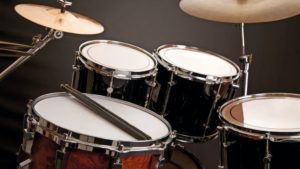Understand the parts of the drum set

Basically, both electric and acoustic drum-sets are expected to produce an ideal sound or sound. Therefore a drummer should pay attention to some things or devices that should support them because it will affect the performance of the drummer during the tour or recording. One such important device is the skin / skin drum better known as the drum-head.
At first the drum-head is made of dried animal skin, so it takes a minimum of 1 hour to warm up assisted by a heater that aims to get the ‘best tune’ at the time. Technological developments helped innovate drum heads up to the present that use ply from drum sheets called million and some even use materials that have their own uniqueness, where the drum-head can still be played even if there is a hole in the middle, very impressive!
Understand the parts of the drum set In general, the performance of drum-head itself can be divided into 3 things, namely:
• Sound (tone, color, pitch, sustain)
• Feel (response, sensitivity)
• Presence (durability, tuning range)
Just as before buying a drum-set or sticks or cymbals, in determining the drum head to be used it’s worth considering the following:
The type of music being played. For example, jazz requires a drum-head that produces an open sound and high tone, or for rock music it requires a typical drum-head that produces a heavy sound and low tone.
The blow character of the drummer, whether a jazz drummer or a rock drummer or an all-around drummer.
By looking at the 2 things mentioned above, at least can help drummer to decide what drum-head will be used, because the drummer will get the picture of drum-head usage based on the consideration of sensitivity (point of Feel) or durability (point of presence).
Drum-head: Batter, Resonant, Snare-side
More deeply, judging by its type then the drum-head is still composed of
Construction of the thickness of the drum-head The standard union of the drum-head is mils where 1 mils = 1/1000 inch Generally the drum-head has a thickness range of 7 mils, 10 mils or 14 mils.
The function and placement of the drum-head, which is divided into:
Better Head,
Drum-heads are made to be hit and placed at the top of the snare and tom-tom as well as on the back of the bass drum.
Resonant Head
The drum-heads are not made to be hit, and are placed on the bottom of the tom-toms and the front of the bass drum
Snare-side
The drum-head is also designed not to be hit and placed at the bottom of the snare so that it can directly interact with the strainer / snare-wire. Snare-side head is different from resonant head on tom-tom, because it has different thickness, is about 2 mils to 5 mils. The thinner snare-side head is then the sound character of the resulting snare will be more bright.
Ambassador and Emperor
For the drummer user it would have been familiar with the names above. There may still be many who think that the three names are variants of drum-head for drum-set. It was not. Ambassador and Emperor is the basic material construction ply from drum-head


 Cooking Smarter
Cooking Smarter